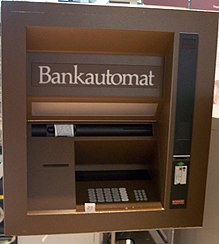

An automated teller machine (ATM) is an electronic telecommunications device that enables customers of financial institutions to perform financial transactions, such as cash withdrawals, deposits, funds transfers, balance inquiries or account information inquiries, at any time and without the need for direct interaction with bank staff.
ATMs are known by a variety of names, including automatic teller machines (ATM) in the United States[1][2][3] (sometimes redundantly as "ATM machine"). In Canada, the term automated banking machine (ABM) is also used,[4][5] although ATM is also very commonly used in Canada, with many Canadian organizations using ATM rather than ABM.[6][7][8] In British English, the terms cashpoint, cash machine and hole in the wall are also used.[9][10][11] ATMs that are not operated by a financial institution are known as "white-label" ATMs.
Using an ATM, customers can access their bank deposit or credit accounts in order to make a variety of financial transactions, most notably cash withdrawals and balance checking, as well as transferring credit to and from mobile phones. ATMs can also be used to withdraw cash in a foreign country. If the currency being withdrawn from the ATM is different from that in which the bank account is denominated, the money will be converted at the financial institution's exchange rate.[12] Customers are typically identified by inserting a plastic ATM card (or some other acceptable payment card) into the ATM, with authentication being by the customer entering a personal identification number (PIN), which must match the PIN stored in the chip on the card (if the card is so equipped), or in the issuing financial institution's database.
According to the ATM Industry Association (ATMIA), as of 2015[update], there were close to 3.5 million ATMs installed worldwide.[13][14] However, the use of ATMs is gradually declining with the increase in cashless payment systems.[15]
- ^ Merriam-Webster Dictionary. Springfield, MA: Merriam-Webster. Archived from the original on 12 August 2017. Retrieved 7 January 2017.
- ^ "FNSRTS307A - Maintain Automatic Teller Machine (ATM) services". training.gov.au. Archived from the original on 7 April 2014.
- ^ Cambridge Dictionary Automatic Teller Machine Archived 7 April 2014 at the Wayback Machine
- ^ "Interac FAQ". Interac Association. Retrieved 28 January 2018.
- ^ "Automated Banking Machine (ABM)". Scotiabank. Archived from the original on 26 November 2022.
- ^ Financial Consumer Agency of Canada (8 June 2018). "ATM fees". Canada.ca. Archived from the original on 29 July 2018. Retrieved 29 July 2018.
- ^ "ATM and Banking Centre Network". CIBC. Archived from the original on 29 July 2018. Retrieved 29 July 2018.
- ^ "TD Green Machine ATM Machines". TD Canada Trust. Archived from the original on 19 July 2019. Retrieved 29 July 2018.
- ^ Merriam-Webster Dictionary. Springfield, MA: Merriam-Webster. Archived from the original on 9 January 2017. Retrieved 7 January 2017.
- ^ "Cashpoint dictionary definition". Merriam-Webster. Retrieved 6 September 2024.
- ^ "Ngram Viewer comparing 3 terms, 2000-2022, UK corpus". Ngram Viewer. Retrieved 6 September 2024.
- ^ Schlichter, Sarah (5 February 2007). "Using ATM's abroad - Travel - Travel Tips". NBC News. Archived from the original on 1 March 2014. Retrieved 11 February 2011.
- ^ "ATM Industry Association". Archived from the original on 16 October 2015.
- ^ Morrison, David (28 July 2014). "3 Million ATMs Worldwide By 2015: ATM Association". Credit Union Times. Archived from the original on 26 June 2015.
- ^ Cummins, Carolyn (1 December 2017). "Shopping centres prepare to go cashless as ATMs disappear". The Age. Archived from the original on 4 December 2017. Retrieved 27 March 2023.